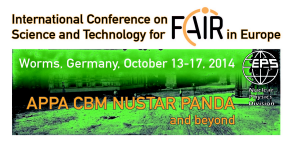Speaker
Dr
Yvonne Leifels
(GSI, Darmstadt)
Description
Understanding the equation of state (EOS) of nuclear matter is of fundamental importance in many areas of nuclear physics and astrophysics [1]. The EOS may be divided into a symmetric matter part independent of the isospin asymmetry and an isospin term, also quoted as symmetry energy $E_{sym}(\rho)$, that enters with a factor $\delta^2$ into the equation of state [2], where $\delta = (\rho_n - \rho_p) / \rho$, where $\rho_n$, $\rho_n$, and $\rho$ are neutron, proton and nuclear matter densities.
The EOS of asymmetric nuclear (neutron) matter is a quantity of crucial significance in understanding the physics of isolated and binary neutron stars, type II supernovae and neutron star mergers. Experimental information about the EOS can help to provide improved predictions for neutron star observables such as stellar radii and moments of inertia, crustal vibration frequencies, and neutron star cooling rates, which are currently being investigated with ground-based and satellite observatories.
In the laboratory, there are different means to study the nuclear matter equation of state and the density dependence of the symmetry energy in particular: nuclear masses, neutron skins, pygmy resonance, and nuclear structure at the drip line give access to nuclear matter properties at densities lower than and at saturation density $\rho_0$. But heavy ion collisions provide the only way to explore densities different from the saturation density $\rho_0$ in the laboratory, as in the course of such a collision matter suffers compression and expansion phases. In the beam energy range of 0.1 to 2.0A GeV nuclear matter is compressed upto three times normal nuclear matter density.
Several observables (e.g. neutron/proton ratios and elliptic flow) from collisions of radioactive and stable beams are predicted to be sensitive to the symmetry energy. The unique opportunities for such studies FAIR will offer will be discussed.
[1] B. A.Li, L. W.Chen and C.M. Ko,``Recent Progress and New Challenges in Isospin Physics with Heavy-Ion Reactions'' Phys. Rept. 464, 113 (2008)
[2] C. Fuchs and H.H. Wolter, ``Modelization of the EOS'' Eur. Phys. J. A 30, 5 (2006)
[3] M. Di Toro, V. Baran, M. Colonna and V. Greco,``Probing the Nuclear Symmetry Energy with Heavy Ion Collisions,'' J. Phys. G 37, 083101 (2011)
Primary authors
Dr
Arnaud Le Fèvre
(GSI)
Prof.
Wolfgang Trautmann
(GSI Helmholtzzentrum GmbH Darmstadt)
Dr
Yvonne Leifels
(GSI, Darmstadt)

